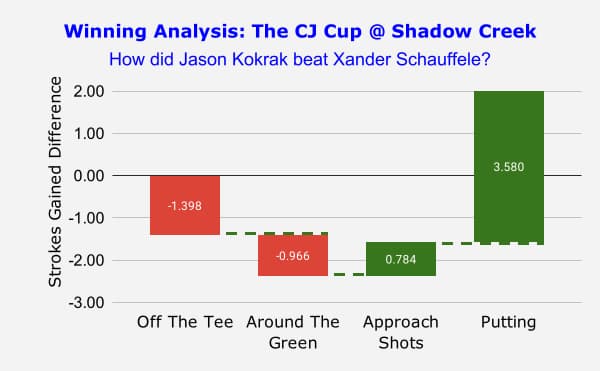Winning Analysis: Jason Kokrak at The CJ Cup
This is the first of a weekly series that analyzes how the latest PGA TOUR winner separated himself from the field, and in particular from the player who came in second. How was the player performing in the season leading up to his victory? What was the strongest part of his game? How did he stack up in each aspect versus his peers last season? These are some of the questions we attempted to answer.
We use the strokes gained methodology to break down the winner’s performance, an approach brought into prominence by Professor Mark Broadie of Columbia University through an analysis of the TOUR’s ShotLink data as laid out in his popular book Every Shot Counts [1], which we highly recommend for the avid golfer and the non-golfer alike.
This data measures the performance of each player versus the rest of the field broken down into four buckets – Off-The-Tee, Approach-The-Green, Around-The-Green, and Putting – with strokes gained (or lost) reported for every player on the PGA Tour website https://www.pgatour.com/stats.html. For history buffs, the PGA TOUR introduced Strokes Gained: Putting in 2011 and Strokes Gained: Tee-to-Green in 2014, which were then broken into 3 buckets namely Off-The-Tee, Approach-The-Green and Around-The-Green in 2016 [2].
How exactly are these data calculated? Using ShotLink data collected since 2004, the PGA TOUR calculated the average number of strokes needed to hole out from every distance and location on the course, which is essentially the “average” TOUR performance baseline. If a player gets the ball in the hole in fewer strokes, he is gaining strokes on the field. For example, on average, it takes TOUR players 3.0 shots to get the ball in the hole from 168 yards out in the fairway. A player who takes 2 shots to hole out would gain 1 shot, conversely taking 4 shots would imply a loss of 1 stroke to the field (reported as a gain of -1.0 strokes).
Let’s take a look at how Jason Kokrak won The CJ Cup @ Shadow Creek by 2 strokes over Xander Schauffele. The chart at the top of the blog shows that despite spotting 2.4 strokes to Xander off the tee and around the green, Jason relied on his approach shots and phenomenal putting to pull off the win. He ranked first in strokes gained putting, gaining a whopping 10.291 strokes over the field through 4 rounds, and attributed a switch earlier this season to a longer putter for the massive improvement over last season where he lost 0.28 strokes to the field every round. He also improved his approach shots and around the green compared to last season, which more than offset a decline in performance off the tee.
In summary, above average ballstriking and a hot putter — always a money making combination!
Strokes gained categories explained:
- Strokes gained: Total = Strokes gained: Off-The-Tee + Strokes gained: Approach-The-green + Strokes gained: Around-The-green + Strokes gained: Putting
- Strokes gained: Off-The-Tee measures player performance off the tee on all par-4s and par-5s.
- Strokes gained: Approach-The-Green include all shots that are not from the tee on par-4 and par-5 holes and are not included in strokes gained: around-the-green and strokes gained: putting. Approach shots include tee shots on par-3s.
- Strokes gained: Around-The-Green measures player performance on any shot within 30 yards of the edge of the green, and does not include any shots taken on the putting green.
Citations:
- Broadie, Mark. Every Shot Counts: Using the Revolutionary Strokes Gained Approach to Improve Your Golf Performance and Strategy. New York: Gotham, 2014.
- https://www.pgatour.com/news/2016/05/31/strokes-gained-defined.html


